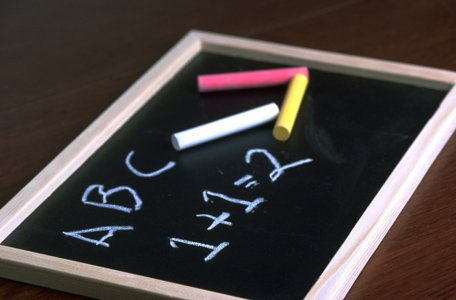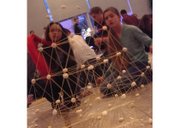This week Education Matters highlights an extraordinary STEM achievement by a group of middle school girls. I am pleased to say my youngest stepdaughter was part of the team that won Johns Hopkins University’s annual Tower of Power competition. In the interest of journalistic integrity I have invited another proud parent, Carol Devecka to write about this remarkable accomplishment. Her daughter Rachael was a member of the team.
Courtesy Photo
The winning tower
On Wednesday February 19, 2014 a group of four middle school girls from the Waldorf School of Baltimore earned an honor they will never forget. After besting seven middle school teams at designing a structure made entirely of marshmallows and spaghetti, they topped that achievement by winning first place against Johns Hopkins University Whiting School of Engineering students and alumni.
This contest is an annual kickoff to celebrate National Engineer Week, and helps to promote STEM education and careers. It is called the “Tower of Power in Half an Hour.” The challenge is to build the highest tower of spaghetti and marshmallows that remains standing throughout the judging period, usually at least fifteen minutes.
This year 15 teams competed, using one bag of marshmallows and one box of spaghetti per team.
Rachel Hopson, (8th), Rachael Stetina (7th), and Fallon Gustin (6th), were invited to the competition after completing a tower in a preliminary round. Then they learned the competitors would have a fourth team member, and invited a friend, Rachael Devecka (7th) to join the team at the last minute. This group had never practiced all together, but they remained excited and unconcerned. A further surprise came when they learned the number of marshmallows they were to receive was half the number they had previously been allowed. It was no problem. They switched to plan B. They are used to working together. They do it every day— in music; in eurythmy; in acting; in science; and in math.
Despite the fact that one team member is deaf and uses in implant in only one ear, the team calmly and flawlessly worked in the noisy room as their tower rose quickly above all the others. And it stayed there.
With one minute left on the clock they had to switch to plan C as the marshmallow deficit rendered the original concept even less sturdy than anticipated. With excited parents and onlookers shouting advice and encouragement, the girls smiled and simply went their own way. They worked together as a beautifully choreographed dance, and won.
Now this may sound like child’s play, but when you stop to think that they topped the engineering students from one of our country’s great engineering and science institutions you realize there is more to it than that. In an era when so many of our current and future careers rely so heavily on science and math, it is indeed something to know that Waldorf achieved this enviable outcome.
And if it still reminds you of child’s play, there is a good reason. The basis for science, cooperation, communication, flexible thinking, creativity, risk-taking and so many of the skills needed in today’s world and illustrated in this design contest are exactly what is found in free play. There is no better way to achieve these goals. And there is no better school to allow these attributes to flourish than the Waldorf School of Baltimore.
At Waldorf, high honors and student achievements don’t make the big waves. But I think word about these girls’ science achievement should spread. And so should word about the school that got them there.
Carol Devecka is the mother of three Waldorf School of Baltimore students. She has a long history with Waldorf education as the daughter of two Waldorf teachers and as a student who attended three different Waldorf schools from pre-kindergarten through twelfth grade. She herself has a lifelong love of science, inspired by her experiences. She studied Health Science and Nursing, and has written primarily for medical professionals.

